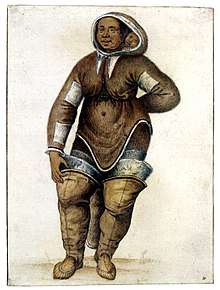Arnaq
| "Arnaq" | |
|---|---|
 Arnaq and her baby Nutaaq in a picture by John White | |
| Born |
unknown North America |
| Died |
1577 Bristol |
| Cause of death | measles |
| Nationality | Canada |
| Known for | travelling to Britain |
| Children | Nutaaq |
| Notes | |
|
Egnock | |
Arnaq or Egnock ( – November 1577) was a Canadian Inuit woman captured by Sir Martin Frobisher on his second journey to find the North West passage. She and her son Nutaaq were amongst the first Native Americans to visit Britain. They arrived and died the same year.
Life
Arnaq was born in North America in the sixteenth century. The name used for her by her captors is very similar to the Inuit word for "woman", so her real name is unknown.
She and Nutaaq were amongst four Inuit brought to Britain against their will by Frobisher.[1] Kalicho died of wounds received by the British. After he had been given a post-mortem by Dr. Edward Dodding, Arnaq was obliged to witness his burial at St Stephen's Church in Bristol on 8 November 1577.[2] Dodding commented on what he saw as her stoicism at Kalicho's fate. Dodding's motives for making Arnaq witness the funeral was because he wanted to ensure that Arnaq did not think that the British were cannibals. Dodding showed Arnaq dead human bones to illustrate his point.[1]
.jpg)
Shortly after the funeral, Arnaq, became ill from what is thought to be measles.[1] She died within days and was buried on the 12 November at St Stephen's church. Kalicho and Arnaq were called Collichang and Egnock respectively in the church's burial records.[2] Arnaq's death left Nutaaq an orphan. Nutaaq was given a nurse and taken to London for a prospective audience with Queen Elizabeth. Nutaaq also died, probably from measles. He was buried without record at St Olave Hart Street church.[1]
Legacy
Arnaq and her son were not the first people from the Americas to visit Europe. Its is estimated that 200 may have visited France in the sixteenth century. However Britain was behind in transatlantic journeys and only a small number of Americans had visited before Arnaq had arrived. Despite not living long, Arnaq, Nutaaq and Kalicho did become well known due to the pictures drawn of them. The most noted of these are by John White who may have been on Frobisher's 1577 voyage.[1] Another two pictures were commissioned by Queen Elizabeth who was disappointed to have not seen Frobishers Inuit.[3] Studies of the portraits show that Arnaq had facial tattoos and details can be noted of the parka she wore.[4]
References
- 1 2 3 4 5 Alden T. Vaughan (11 December 2006). Transatlantic Encounters: American Indians in Britain, 1500-1776. Cambridge University Press. pp. 3–10. ISBN 978-0-521-86594-4.
- 1 2 Dodding, Edward (1577). "1577_____________The Death of an Inuit Man in England" (PDF). nationalhumanitiescenter.org. Retrieved 12 August 2017.
- ↑ Alden T. Vaughan, 'American Indians in England (act. c.1500–1615)', Oxford Dictionary of National Biography, Oxford University Press, 2004; online edn, April 2016 accessed 12 Aug 2017
- ↑ Christian F. Feest (1987). Indians and Europe: An Interdisciplinary Collection of Essays. U of Nebraska Press. pp. 90–. ISBN 0-8032-6897-1.
External links
![]()